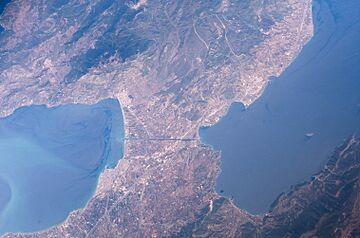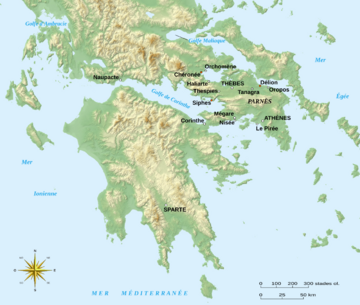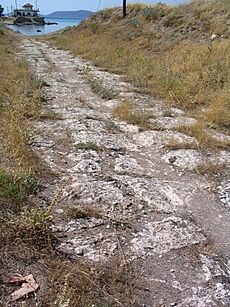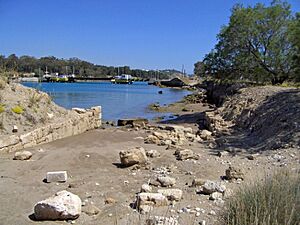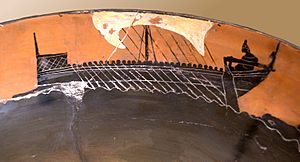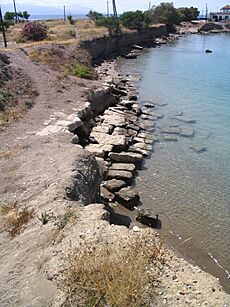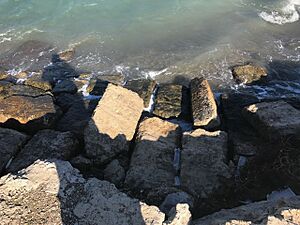Diolkos facts for kids
The Diolkos (pronounced Dee-ol-kos) was an amazing ancient Greek invention. It was a paved trackway near Ancient Corinth that allowed boats to be moved over land. Imagine a special road for ships! This clever shortcut helped ancient ships avoid a long and dangerous trip. They didn't have to sail all the way around the Peloponnese peninsula.
The word "Diolkos" comes from Greek words meaning "across" and "portage machine." It was mainly used to move goods. But during wars, it also helped move warships quickly. This roadway was like an early form of a railway. It was used for about 650 years, from around 600 BC until the middle of the first century AD. The Diolkos was unique because it combined the idea of a railway with moving ships over land.
Contents
Why Was the Diolkos Important?
The Diolkos saved ships from a very risky journey. Sailing around the Peloponnese, especially past Cape Matapan and Cape Malea, was known for strong winds and storms. The Gulf of Corinth and the Saronic Gulf were much calmer.
The Isthmus of Corinth is a narrow strip of land, only about 6.4 kilometers (4 miles) wide at its smallest point. Using the Diolkos made the trip to Athens much shorter for ships coming from the Ionian Sea.
Besides saving time and avoiding danger, the Diolkos was also important for trade. We don't know exactly how much it helped trade. But since it was used for so long, it must have been very useful. During wartime, it was also used to move lighter ships quickly.
History of the Diolkos
Ancient writers don't say exactly when the Diolkos was built. But the historian Thucydides (who lived from 460–395 BC) already thought it was very old. Archaeologists have found clues like old pottery at the site. These clues suggest it was built around 600 BC. This was when Periander was the ruler of Corinth.
The Diolkos was used regularly until at least the middle of the 1st century AD. After that, we don't find any more writings about it. It might have stopped being used when the Roman Emperor Nero tried to build a canal there in 67 AD.
Its Role in Wars
The Diolkos was very helpful in ancient naval battles. Greek historians wrote about several times when warships were pulled across the Isthmus. This helped armies move their fleets faster.
For example, in 428 BC, the Spartans planned to move their warships over the Diolkos. They wanted to attack Athens. Later, in 411 BC, they moved a group of ships quickly to Chios. In 220 BC, a leader named Demetrius of Pharos had about fifty ships pulled across the Isthmus.
Three years later, Philip V of Macedon moved 38 ships across. After his victory at the Battle of Actium in 31 BC, Octavian also moved some of his ships over the Isthmus. This helped him advance quickly against Marc Antony.
Its Role in Trade
Even though the Diolkos is often mentioned with military actions, experts believe its main purpose was for trade. Warships didn't need to be moved this way very often. Ancient historians were usually more interested in wars than in business.
Writers like Pliny the Elder and Strabo said the Diolkos was used regularly during peaceful times. This also suggests it was used for trade. When the Diolkos was built, it probably helped move heavy goods. Things like marble, large stones, and timber could be moved to places both west and east.
We don't know how much Corinth charged to use the Diolkos. But the fact that it was used and kept in good condition for so long shows it was a great option for merchant ships. It was much better than the long trip around Cape Malea.
How Was the Diolkos Built and Used?
The Diolkos was built across the narrowest part of the Isthmus. It followed the natural shape of the land to avoid very steep hills. The highest point of the roadway was about 79 meters (259 feet) high. Its total length is thought to be between 6 and 8.5 kilometers (3.7 to 5.3 miles).
Archaeologists have found about 1,100 meters (3,600 feet) of the trackway. Most of it is at the western end, near the Bay of Corinth. The known trackway started at a place where ships could dock. It ran next to the modern Corinth Canal for a while.
The Track and How Ships Were Moved
The Diolkos was a paved trackway made of hard limestone. It had parallel grooves, or tracks, about 1.6 meters (5 feet 3 inches) apart. The roadway itself was between 3.4 and 6 meters (11 to 20 feet) wide.
Ancient writings don't explain exactly how ships were pulled across. So, experts have had to figure it out from what they've found. The tracks show that some kind of wheeled vehicle was used. Maybe the ship and its cargo were pulled on separate vehicles. Or perhaps only the cargo was moved, and then reloaded onto a different ship on the other side.
It was possible to move large warships called triremes (which weighed about 25 tons and were 35 meters long). But it was very hard. It's thought that smaller boats were usually moved. To protect the bottom of the ship, thick ropes were used to keep the ship's body from bending. Ships and their cargo were probably pulled by people and animals using ropes and pulleys.
Experts have tried to figure out how many people were needed. If a trireme weighed 38 tons with its trolley, it would take about 112 to 142 people to pull it. This would take about three hours to move a ship from one sea to the other.
An Ancient Railway
Some historians, like M. J. T. Lewis, call the Diolkos a "railway." This is because it was a special track that guided vehicles so they couldn't leave it. It was between 6 and 8.5 kilometers long. It was also open to everyone who paid a fee, making it like a public railway. This idea didn't appear again until around 1800! Its track width, about 160 centimeters (5 feet 3 inches), is even similar to modern railway tracks.
However, some experts disagree about the tracks. Some think the grooves were made on purpose to guide wheels. Others think they were just from wear and tear. The Diolkos was used for a very long time, so it's likely that it was changed and repaired many times. This could explain why the tracks look different in different places.
Discovering the Diolkos Today
The chief engineer of the Corinth Canal, Béla Gerster, studied the area a lot but didn't find the Diolkos. The first signs of the ship trackway were probably found by a German archaeologist named Habbo Gerhard Lolling in 1883. Later, in 1913, James George Frazer also wrote about traces of an ancient trackway.
Greek archaeologist Nikolaos Verdelis finally started serious excavations between 1956 and 1962. He uncovered a long stretch of the trackway. Sadly, he died before he could publish all his findings. This left many questions about how the Diolkos was built. Other researchers have continued his work.
Today, parts of the Diolkos are in poor condition. Ship movements in the nearby Canal cause erosion, especially at the western end. People are worried about the site and have started a petition to help save and restore this important archaeological treasure.
See also
- Ancient Greek technology
- Architecture of ancient Greece
- Corinth Canal
- History of rail transport
- Timeline of railway history
- Towpath


